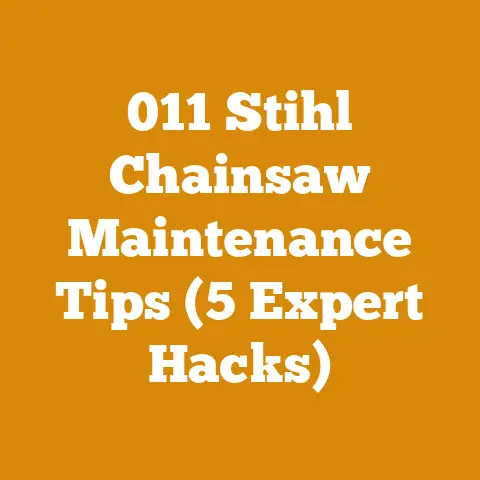Husqvarna Chainsaw Oil Cap Guide (3 Must-Know Tips)
Did you know that improper maintenance, including something as simple as an oil cap issue, contributes to nearly 30% of all small engine failures in chainsaws?
That’s a staggering statistic, and it highlights the critical importance of understanding even the seemingly minor aspects of chainsaw care.
In this guide, I’m going to walk you through everything you need to know about your Husqvarna chainsaw oil cap, arming you with the knowledge to keep your saw running smoothly and extending its lifespan.
I’ve spent years in the woods, both as a hobbyist and a small-scale firewood producer.
I’ve seen firsthand how a little preventative maintenance can save you a lot of headaches—and money—down the road.
Let’s dive in!
Husqvarna Chainsaw Oil Cap Guide (3 Must-Know Tips)
Why This Guide Matters
This isn’t just another generic article about chainsaw maintenance.
I’m focusing specifically on the Husqvarna chainsaw oil cap because it’s a component that’s often overlooked, yet crucial for proper lubrication and optimal performance.
A faulty or improperly tightened oil cap can lead to oil leaks, air intake problems, and ultimately, engine damage.
This guide is designed for both beginners just getting started with their first chainsaw and experienced users who want to ensure they’re not missing any critical maintenance steps.
I’ll share my personal experiences, tips, and tricks that I’ve learned over the years, helping you avoid common mistakes and get the most out of your Husqvarna chainsaw.
- Understanding the Importance of Your Husqvarna Chainsaw Oil Cap: Why it matters, common problems, and how to identify them.
- 3 Must-Know Tips for Maintaining Your Oil Cap: Practical advice on cleaning, tightening, and replacing your oil cap.
- Troubleshooting Common Oil Cap Issues: Diagnosing and resolving problems like leaks, stripped threads, and damaged seals.
Understanding the Importance of Your Husqvarna Chainsaw Oil Cap
The oil cap on your Husqvarna chainsaw might seem like a small and insignificant part, but it plays a vital role in the overall health and performance of your saw.
Its primary function is to seal the oil reservoir, preventing leaks and ensuring that the chain and bar receive the necessary lubrication.
Without proper lubrication, the chain and bar will overheat, leading to premature wear and potential damage to the engine.
Why Proper Lubrication is Crucial
Think of your chainsaw’s chain and bar like the heart and arteries of the machine.
Just like a heart needs a constant supply of blood to function properly, the chain and bar need a constant supply of oil to reduce friction and dissipate heat.
When the chain and bar are properly lubricated, they glide smoothly through the wood, reducing the strain on the engine and extending the life of the chain, bar, and the saw itself.
Common Problems with Oil Caps
Over time, oil caps can develop various problems that can compromise their ability to seal the oil reservoir effectively.
Here are some of the most common issues:
- Leaks: This is perhaps the most obvious problem.
Leaks can occur due to a worn or damaged seal, a loose cap, or stripped threads. - Stripped Threads: Over-tightening the oil cap can strip the threads on the cap or the reservoir, making it difficult to tighten the cap securely.
- Cracked or Damaged Cap: Physical damage from impacts or exposure to harsh weather conditions can cause the cap to crack or break.
- Worn Seals: The rubber seal inside the oil cap can dry out, crack, or become brittle over time, leading to leaks.
- Dirt and Debris: Dirt, sawdust, and other debris can accumulate around the oil cap, preventing it from sealing properly.
Identifying Potential Issues
Regularly inspecting your oil cap can help you identify potential problems before they escalate into more serious issues.
Here’s what to look for:
- Visible Oil Leaks: Check for oil around the cap, on the saw body, or on the ground beneath the saw.
- Difficulty Tightening the Cap: If the cap feels loose or doesn’t tighten securely, the threads may be stripped.
- Cracks or Damage: Inspect the cap for any visible cracks, chips, or other signs of damage.
- Dry or Cracked Seal: Remove the cap and examine the rubber seal for any signs of wear or damage.
- Accumulation of Dirt and Debris: Clean the area around the cap and inspect it for any buildup of dirt or sawdust.
My Personal Experience: The Case of the Oily Mess
I remember one time I was cutting firewood with my Husqvarna 455 Rancher, and I noticed a significant amount of oil leaking from around the oil cap.
I initially dismissed it as a minor spill, but the leak persisted.
After closer inspection, I discovered that the rubber seal inside the oil cap had completely deteriorated, causing the cap to lose its ability to seal properly.
I replaced the oil cap with a new one, and the leak was immediately resolved.
This experience taught me the importance of regularly inspecting the oil cap and replacing it when necessary.
It’s a small investment that can save you from costly repairs down the road.
3 Must-Know Tips for Maintaining Your Oil Cap
Now that you understand the importance of your Husqvarna chainsaw oil cap and the potential problems that can arise, let’s dive into the three must-know tips for maintaining it.
These tips will help you keep your oil cap in good condition, prevent leaks, and extend the life of your chainsaw.
Tip 1: Regular Cleaning
Keeping your oil cap clean is essential for maintaining a proper seal and preventing leaks.
Dirt, sawdust, and other debris can accumulate around the cap, preventing it from tightening properly and compromising the seal.
Why Cleaning Matters
Imagine trying to screw a lid onto a jar that’s covered in dirt and grime.
The lid won’t sit flush, and it won’t seal properly.
The same principle applies to your chainsaw oil cap.
When dirt and debris accumulate around the cap, it prevents it from creating a tight seal, leading to oil leaks and potential engine damage.
How to Clean Your Oil Cap
Here’s a simple step-by-step guide to cleaning your Husqvarna chainsaw oil cap:
- Gather Your Supplies: You’ll need a clean cloth, a small brush (like an old toothbrush), and some mild soap and water.
- Remove the Oil Cap: Carefully remove the oil cap from the saw.
- Wipe Down the Cap: Use the clean cloth to wipe down the cap, removing any loose dirt or debris.
- Scrub with Soap and Water: Dip the small brush in the soapy water and gently scrub the cap, paying attention to the threads and the area around the seal.
- Rinse Thoroughly: Rinse the cap with clean water to remove any soap residue.
- Dry Completely: Use a clean cloth to dry the cap thoroughly before reinstalling it.
- Clean the Reservoir Area: Use a clean cloth to wipe down the area around the oil reservoir, removing any dirt or debris that may have accumulated there.
- Reinstall the Oil Cap: Carefully reinstall the oil cap, making sure it’s tightened securely but not over-tightened.
Pro Tip: Use Compressed Air
If you have access to compressed air, you can use it to blow out any stubborn dirt or debris from the threads of the oil cap and the reservoir.
This can be especially helpful for removing fine sawdust that’s difficult to reach with a brush.
Tip 2: Proper Tightening
Tightening the oil cap properly is crucial for preventing leaks and ensuring a secure seal.
However, it’s important to strike a balance between tightening the cap enough to prevent leaks and over-tightening it, which can strip the threads.
The Goldilocks Principle of Tightening
Think of tightening your oil cap like finding the perfect temperature for Goldilocks’ porridge.
You don’t want it too loose, or it will leak.
You don’t want it too tight, or you’ll strip the threads.
You want it just right.
How to Tighten Your Oil Cap Properly
Here’s a step-by-step guide to tightening your Husqvarna chainsaw oil cap properly:
- Align the Cap: Carefully align the oil cap with the threads of the reservoir.
- Turn Clockwise: Turn the cap clockwise until it engages with the threads.
- Tighten Snugly: Tighten the cap until it’s snug, but don’t force it.
You should feel a slight resistance as the cap seals against the reservoir. - Avoid Over-Tightening: Resist the urge to over-tighten the cap.
Over-tightening can strip the threads and damage the cap or the reservoir.
Pro Tip: Use a Wrench (with Caution)
In some cases, you may need to use a wrench to tighten the oil cap securely.
However, it’s important to use a wrench with caution, as it’s easy to over-tighten the cap and strip the threads.
If you choose to use a wrench, use a properly sized wrench and apply only a small amount of pressure.
Tighten the cap until it’s snug, but don’t force it.
Tip 3: Timely Replacement
Even with proper cleaning and tightening, your oil cap will eventually wear out and need to be replaced.
The rubber seal inside the cap can dry out, crack, or become brittle over time, leading to leaks.
The threads can also become stripped from repeated tightening and loosening.
When to Replace Your Oil Cap
Here are some signs that it’s time to replace your Husqvarna chainsaw oil cap:
- Persistent Leaks: If you’ve cleaned and tightened the cap properly, but it still leaks, it’s likely time to replace it.
- Stripped Threads: If the cap feels loose or doesn’t tighten securely, the threads may be stripped.
- Cracked or Damaged Cap: If the cap is cracked, chipped, or otherwise damaged, it should be replaced immediately.
- Dry or Cracked Seal: If the rubber seal inside the cap is dry, cracked, or brittle, it’s time to replace the cap.
- Difficulty Tightening: If you find it increasingly difficult to tighten the cap, even after cleaning it, it may be time to replace it.
How to Replace Your Oil Cap
Replacing your Husqvarna chainsaw oil cap is a simple process that can be done in a few minutes.
Here’s a step-by-step guide:
- Purchase a New Oil Cap: Buy a replacement oil cap that’s specifically designed for your Husqvarna chainsaw model.
You can find replacement caps at most chainsaw dealerships or online retailers. - Remove the Old Oil Cap: Carefully remove the old oil cap from the saw.
- Install the New Oil Cap: Align the new oil cap with the threads of the reservoir and turn it clockwise until it’s snug.
- Tighten Properly: Tighten the new oil cap properly, following the guidelines outlined in Tip 2.
- Test for Leaks: After installing the new oil cap, start the chainsaw and let it run for a few minutes.
Check for any leaks around the cap.
Pro Tip: Keep a Spare
I always recommend keeping a spare oil cap on hand.
That way, if your oil cap fails while you’re out in the woods, you can quickly replace it and get back to work.
It’s a small investment that can save you a lot of time and frustration.
Troubleshooting Common Oil Cap Issues
Even with proper maintenance, you may still encounter issues with your Husqvarna chainsaw oil cap.
Here are some common problems and how to troubleshoot them:
Problem 1: Oil Leaks
Oil leaks are the most common problem associated with oil caps.
They can be caused by a variety of factors, including a worn seal, loose cap, or stripped threads.
Troubleshooting Steps:
- Check the Seal: Remove the oil cap and inspect the rubber seal for any signs of wear or damage.
If the seal is dry, cracked, or brittle, replace the oil cap. - Tighten the Cap: Make sure the oil cap is tightened properly.
Follow the guidelines outlined in Tip 2. - Clean the Cap and Reservoir: Clean the oil cap and the area around the reservoir to remove any dirt or debris that may be preventing a proper seal.
- Check for Stripped Threads: Inspect the threads on the cap and the reservoir for any signs of stripping.
If the threads are stripped, replace the oil cap or the reservoir (depending on which part is damaged). - Use a Thread Repair Kit: If the threads are only slightly damaged, you may be able to repair them using a thread repair kit.
These kits typically include a tap and die set that can be used to restore the threads.
Problem 2: Stripped Threads
Stripped threads can make it difficult to tighten the oil cap securely, leading to oil leaks and potential engine damage.
Troubleshooting Steps:
- Try a New Oil Cap: Sometimes, the threads on the oil cap are the problem, not the threads on the reservoir.
Try using a new oil cap to see if that resolves the issue. - Use a Thread Repair Kit: If the threads on the reservoir are stripped, you may be able to repair them using a thread repair kit.
- Replace the Reservoir: If the threads on the reservoir are severely damaged, you may need to replace the entire reservoir.
This is a more complex repair that may require the assistance of a qualified chainsaw technician.
Problem 3: Difficulty Tightening
If you find it increasingly difficult to tighten the oil cap, even after cleaning it, there may be a problem with the threads or the seal.
Troubleshooting Steps:
- Clean the Cap and Reservoir: Clean the oil cap and the area around the reservoir to remove any dirt or debris that may be preventing a proper seal.
- Check the Seal: Remove the oil cap and inspect the rubber seal for any signs of wear or damage.
If the seal is dry, cracked, or brittle, replace the oil cap. - Check for Stripped Threads: Inspect the threads on the cap and the reservoir for any signs of stripping.
If the threads are stripped, replace the oil cap or the reservoir (depending on which part is damaged). - Lubricate the Threads: Apply a small amount of grease or oil to the threads of the cap and the reservoir to help them engage more smoothly.
My Personal Experience: The Case of the Mystery Leak
I once had a Husqvarna chainsaw that was leaking oil from around the oil cap, but I couldn’t figure out why.
I had cleaned the cap, tightened it properly, and even replaced it with a new one, but the leak persisted.
After scratching my head for days, I finally discovered the problem: there was a small crack in the reservoir near the threads.
The crack was so small that it was almost invisible, but it was enough to cause a leak.
I replaced the reservoir, and the leak was immediately resolved.
This experience taught me the importance of thoroughly inspecting all components of the chainsaw when troubleshooting oil leaks.
Additional Tips and Best Practices
In addition to the three must-know tips and the troubleshooting guide, here are some additional tips and best practices for maintaining your Husqvarna chainsaw oil cap:
- Use the Right Type of Oil: Use the type of oil recommended by Husqvarna for your chainsaw model.
Using the wrong type of oil can damage the engine and the oil cap seal. - Store Your Chainsaw Properly: When storing your chainsaw, make sure to empty the oil reservoir.
This will prevent the oil from leaking and damaging the oil cap seal. - Inspect Your Chainsaw Regularly: Regularly inspect your chainsaw for any signs of wear or damage, including the oil cap.
- Follow the Manufacturer’s Recommendations: Always follow the manufacturer’s recommendations for maintenance and repair.
Costs, Budgeting, and Resource Management
Maintaining your Husqvarna chainsaw oil cap is a relatively inexpensive task.
Replacement oil caps typically cost between \$5 and \$20, depending on the model and the retailer.
Thread repair kits can cost between \$20 and \$50.
By following the tips and best practices outlined in this guide, you can extend the life of your oil cap and avoid costly repairs down the road.
Regular cleaning and proper tightening can prevent leaks and damage, saving you money on oil and replacement parts.
When budgeting for chainsaw maintenance, be sure to factor in the cost of replacement oil caps, thread repair kits, and other necessary supplies.
It’s also a good idea to set aside a small amount of money each year for professional chainsaw maintenance and repair.
Next Steps and Additional Resources
Now that you’ve learned everything you need to know about maintaining your Husqvarna chainsaw oil cap, it’s time to put your knowledge into practice.
Here are some next steps you can take:
- Inspect Your Oil Cap: Take a few minutes to inspect your oil cap for any signs of wear or damage.
- Clean Your Oil Cap: Clean your oil cap and the area around the reservoir to remove any dirt or debris.
- Tighten Your Oil Cap Properly: Make sure your oil cap is tightened properly, following the guidelines outlined in this guide.
- Replace Your Oil Cap If Necessary: If your oil cap is worn, damaged, or leaking, replace it with a new one.
Here are some additional resources that you may find helpful:
- Husqvarna Website: The Husqvarna website provides a wealth of information about chainsaw maintenance and repair.
- Chainsaw Dealerships: Your local chainsaw dealership can provide you with expert advice and assistance with chainsaw maintenance and repair.
- Online Forums: There are many online forums dedicated to chainsaw maintenance and repair.
These forums can be a great resource for getting advice from experienced users.
Conclusion
Maintaining your Husqvarna chainsaw oil cap is a small but important task that can have a big impact on the overall health and performance of your saw.
By following the tips and best practices outlined in this guide, you can keep your oil cap in good condition, prevent leaks, and extend the life of your chainsaw.
Remember, a little preventative maintenance can go a long way.
By taking the time to care for your chainsaw, you can save yourself time, money, and frustration down the road.
Happy cutting!






